New perk! Get after it with local recommendations just for you. Discover nearby events, routes out your door, and hidden gems when you sign up for the Local Running Drop.
Photos by Fred Marmsater
When she topped out on Grant-Swamp Pass at sunrise on the second day, Darcy Piceu was 15 miles from the finish of the 2015 Hardrock 100 Endurance Run. She was on personal-best pace, and, for the first time in 24 hours of running, held the lead.
Known for racing smart and steady, Piceu had won Hardrock the previous three years. Each time, course-record holder Diana Finkel had gone out fast, led for 85 or 90 miles, then dropped for medical reasons.
Though Finkel wasn’t running, this year’s race followed a similar pattern. At her first Hardrock, New Zealander Anna Frost led by 15 to 20 minutes until evening, when she crashed hard. In Wasatch Basin, some 77 miles in, Piceu finally caught up.
But Frost was hanging on. At Grant-Swamp Pass, mile 86, she and Piceu were just 10 minutes apart.
Hardrock began in 1992, as an homage to the hard-rock miners who blazed many of the trails that criss-cross Colorado’s craggy San Juan Mountains. The 100.5-mile loop course, alternating directions each year, starts in tiny Silverton. It crosses 13 12,000-foot-plus passes, gains and loses a total of 66,000 feet and climbs 14,048-foot Handies Peak. The average elevation is 11,019 feet.
As with any 23-year-old mountain run, Hardrock has its quirks: an aid station that serves tequila, a convoluted three-tier lottery system and a painted sandstone “hardrock” that finishers kiss, in lieu of crossing a line.
It also inspires loyalty like few other races. Longtime runners credit this to the aesthetic course, unparalleled challenge and tight-knit community. Pioneering Hardrockers, past winners and middle-of-the-pack mainstays return to Silverton, July after July, whether they’re running, crewing, pacing or just catching up with old friends.
“I connected to people out there, within hours, more than I’ve connected to people in Memphis I’ve known for a lifetime,” says 10-time finisher Billy Simpson. “I don’t even see them but once a year. But they’re truly like family.”
Here, we tell the story of this year’s Hardrock, held July 10 through 12, through portraits of its runners.
—
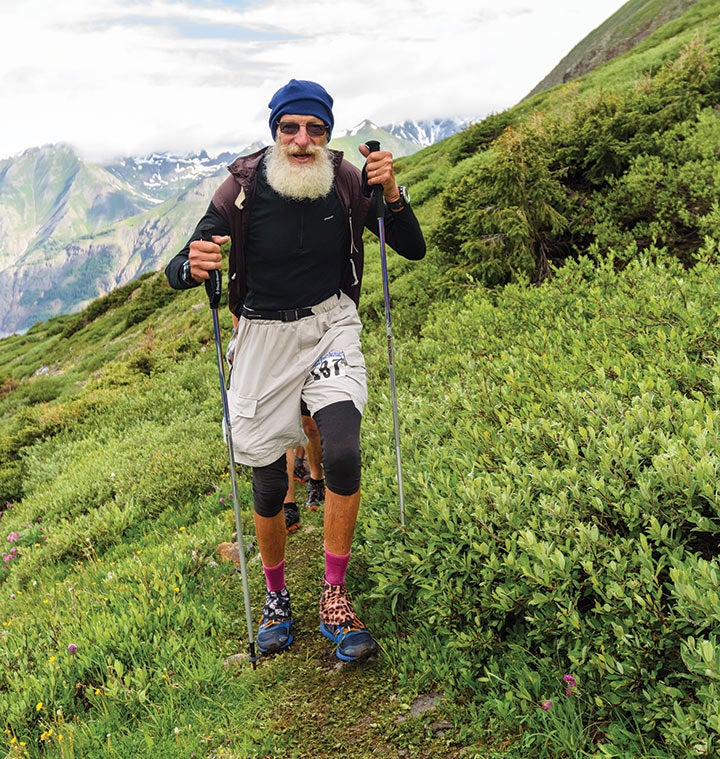
Hans-Dieter Weisshaar / 75 / Germany / 8 Hardrock finishes
The climb up Little Giant, around mile 6
2015 result: DNF, mile 28.7
Hans-Dieter Weisshaar, Hardrock’s oldest finisher—he was 73 in 2013, when he kissed the hardrock for the eighth time—has been a fixture on the American trail-running circuit for about a decade and a half. A physician from Kassel, Germany, Weisshaar began running ultras after coming to the U.S. in 1999 and hearing about 100-mile races.
Weisshaar, who retired in 2001, spends his summers in the States, traveling from race to race in a small white RV with German plates, an idyllic landscape painted on the side and the German flag across the back. To date, he has run over 100 100-milers. In 2013, he finished the Rocky Mountain Slam—Hardrock, the Leadville Trail 100, the Wasatch Front 100 and the Bear 100, a grand total of 99,000 feet of elevation gain—and, for good measure, threw in a fifth, Cascade Crest, in Washington state.
Going for his ninth Hardrock finish this year, the 75-year-old Weisshaar dropped at Sherman aid station, mile 29, shortly before 6 p.m. the first day.
—
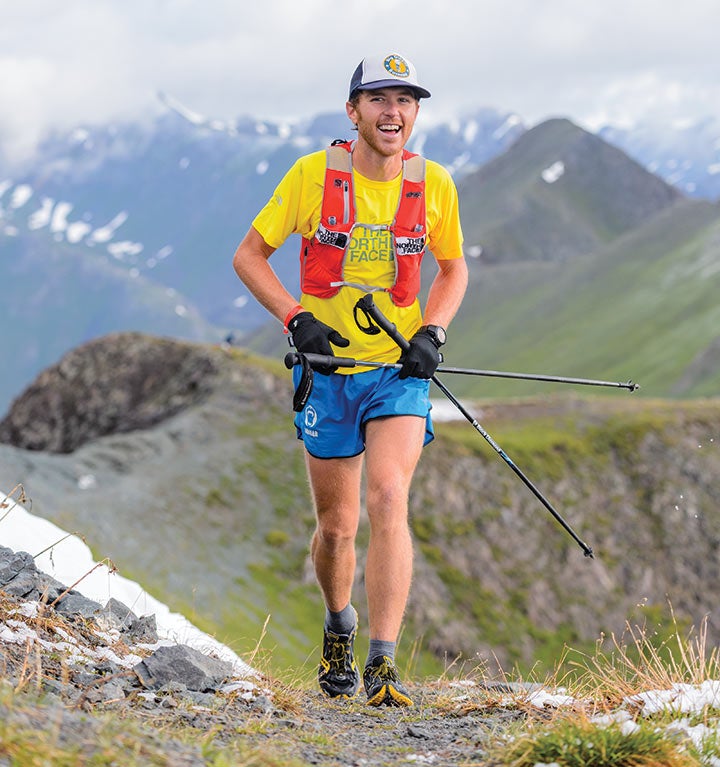
Mike Foote / 31 / Missoula, MT / 2 Hardrock finishes
Little Giant Pass, mile 7.0
2015 result: 25:45:13 (2nd overall)
Aside from baseball games and a season of junior-high cross country, Mike Foote didn’t run much during the first 18 years of his life. Then he spent a semester in the Rockies with the National Outdoor Leadership School, “found out about the mountains” and dropped out of college. He moved to Colorado, then to Montana, where he worked as a raft guide in Glacier National Park, tagging peaks on his off days.
In 2009, Foote ran his first 100-miler, the Wasatch Front 100 in Utah, which climbs more than 25,000 feet. His second 100-miler was Hardrock, one year later.
“I didn’t know what the hell I was getting into,” Foote says. His training had been spotty, and all he knew about the course was that “it would be steep and long.” He finished third, in 29:35.
The experience was “formative,” he says, “this sense of awe that you have when you’re discovering something new.”
Foote returned this year with more than 20 ultras under his belt and a “healthy respect for Hardrock” that he lacked the first time. Paradoxically, his familiarity with the course made him less confident: he was aware of its difficulty. At the same time, he knew an up-and-down race like Hardrock played to his strengths. “It’s more about efficient mountain travel, not so much about running,” he says.
Early in the race, Foote kept his mountain travel slow, but just before halfway he moved into second place. He knew he couldn’t beat first-place Kilian Jornet, but thought he could come close to the 24:25 course record Jornet would break the next morning.
Around 2 a.m., almost 80 miles in, Foote drifted off course and wandered around for 50 minutes in sleet and snow. The 25-hour mark now looked out of reach. But he still held on to second place; everyone else in the top five had gotten lost, too. Foote left the next aid station one minute before third-place Adam Campbell, and ran hard for the final 18 miles. When he reached Silverton he had widened the gap by 63 minutes.
Foote jogged toward the finish, stopping a few feet short. He kissed his girlfriend, then walked over and kissed the rock.
—
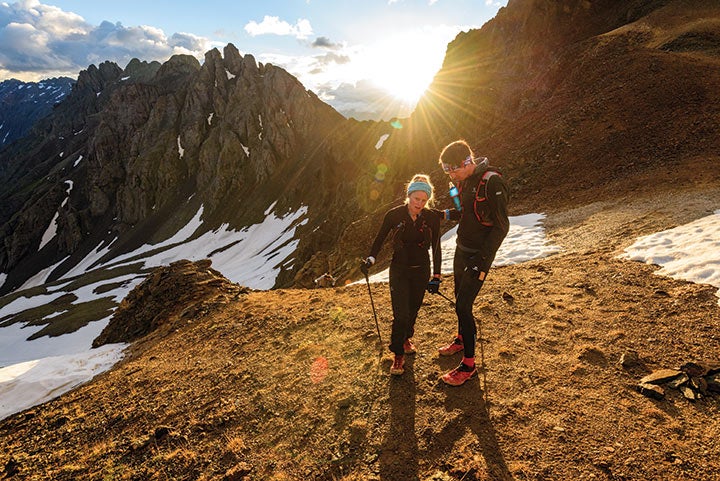
Anna Frost (with pacer Erik Skaggs) / 33 / New Zealand / 1 Hardrock finish
Grant-Swamp Pass, mile 85.6
2015 result: 28:22:47 (1st female, 8th overall)
Before this year’s race, the Darcy Piceu-Anna Frost matchup was seen as one of experience versus speed. Frost, who’s been podium-finishing at competitive mountain ultras since 2010, ran her first 100-miler, Utah’s Bear 100, less than a year ago. (She set a course record.) Without the course knowledge or 100-mile pedigree of Piceu, Frost spent the six weeks before Hardrock training in Silverton.
To observers, Frost started fast, but she didn’t feel she was pushing too hard: “My legs felt fine. I wasn’t really breathing hard. I’d acclimatized well. I was eating well. What really took me down was the cold.”
The day of the race was chillier than she expected. That evening, as she descended the 5,000 feet from Engineer Mountain to Ouray, at mile 57, a storm drenched her. She left Ouray, slogging up 10 miles and 5,000 vertical feet of dirt road, topped off with steep, snowy cross-country climbs. When she reached the top of the climb, Virginius Pass, just before 11 p.m., she was “frozen,” her legs were quitting and she felt herself “losing the will to carry on.” She has no memory whatsoever of her midnight stop at the next aid station, in the town of Telluride.
Frost left Telluride at 12:15 a.m. Three minutes later, second-place Darcy Piceu arrived. Since leaving Ouray four-and-a-half hours earlier, Piceu had all but erased Frost’s 24-minute lead. She caught up a few miles later, in Wasatch Basin. The two women hugged and exchanged encouraging words.
Frost, so tempted to sleep that her pacer Erik Skaggs had to talk her out of lying down on the cold ground, “really didn’t care” about losing the lead. More than anything, she remembers her amazement that Piceu wore only shorts, a T-shirt and a jacket while, Frost says, “I had every layer in the world on. And I was freezing, still.”
A few hours later, they appraoched Grant-Swamp Pass, the run’s 11th climb. “It’s only an hour before the sun comes up,” Skaggs was saying. Frost didn’t understand why he kept telling her this until
it happened.
“I could hear the birds chirping and see the glow in the sky,” she says. She felt the sun on her body and thought, “Oh, wow. OK. Now I’m warm and awake and alive.”
The two spotted Piceu and her pacer at the top of Grant-Swamp Pass, a mere 10 minutes ahead. “The time is now or never,” Skaggs told her. Frost listened. She caught Piceu minutes from the mile-89 KT aid station, where she met her crew. “The guys had just seen me a couple hours before in a heap under a blanket,” she says. At KT, to their bemusement, “I come flying through.” She switched pacers, grabbed Cokes and caffeine gels, and kept flying.
When Frost got to the roped crossing of Mineral Creek, at mile 98, she was 14 minutes ahead. Her pacer, Ron Brazelton, told her she could relax: Piceu wouldn’t catch her. Frost didn’t care. She stowed her trekking poles and ran the final 2.3 miles as hard as she could. Her split for that section was faster than that of the men’s winner, Kilian Jornet. Not till she entered Silverton did she realize she was about to finish Hardrock. Brazelton had to remind her that she was about to win it, too.
Frost made one last turn, hugged her mother and father, and, 28 hours 22 minutes 47 seconds into Hardrock, realized her “unreal dream” of kissing the painted hunk of sandstone that marks the finish. A half-hour later, Piceu did the same, in a personal-best 28:57:07, as only the third woman, after Diana Finkel and Frost, to break 29 hours.
—
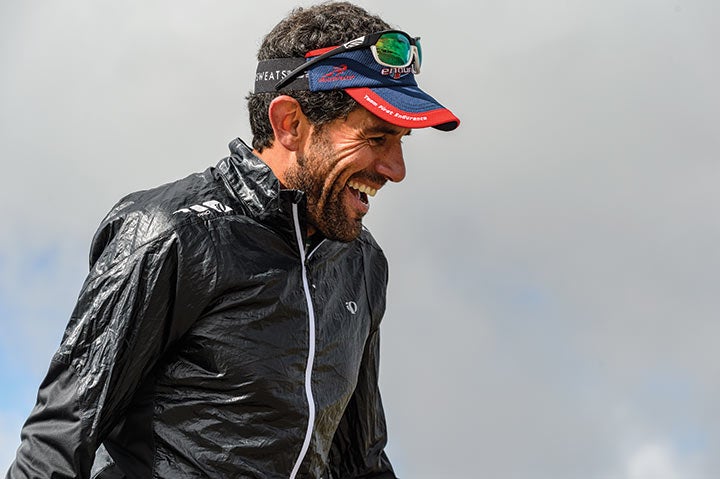
Scott Jaime / 45 / Highlands Ranch, CO / 8 Hardrock finishes
Buffalo Boy Ridge, mile 13.7
2015 result: DNF, mile 42.1
Over the first pass, the leaders’ pace had been relaxed, but as they began the 3,000-foot climb up Green Mountain, they sped up and Scott Jaime doubled over coughing. For weeks, he’d suffered from a dry, hacking cough on every long training run.
Slowing, he mustered the energy to summit the course’s high point, Handies Peak—“If I can make it over Handies, I think I can finish this race,” he thought—but when, 17 hours after starting, he sat down at the next aid station and tried to talk, his voice was hoarse and he fell into another fit of coughing.
Around 2004, he says, “I read an article in Trail Runner magazine that scared the shit out of me.” Jaime, who ran his first marathon at 11, wondered, “What are my limits? What am I genetically capable of?”
He’s been capable, so far, of 26:38. This year he wanted to break 26, to “compete against my best ghost,” he says.
Jaime, hacking all the way, hiked up the jeep road to the next pass, on Engineer Mountain. His father-in-law waited in a 4×4. Jaime looked at the lush green landscape, lit by streaks of late-afternoon sun. He thought of the old saw, “Pain is inevitable, but suffering is optional,” and knew he had nothing to prove. “I got on the four-wheeler,” he says, “and came back down, and that was my race.”
—
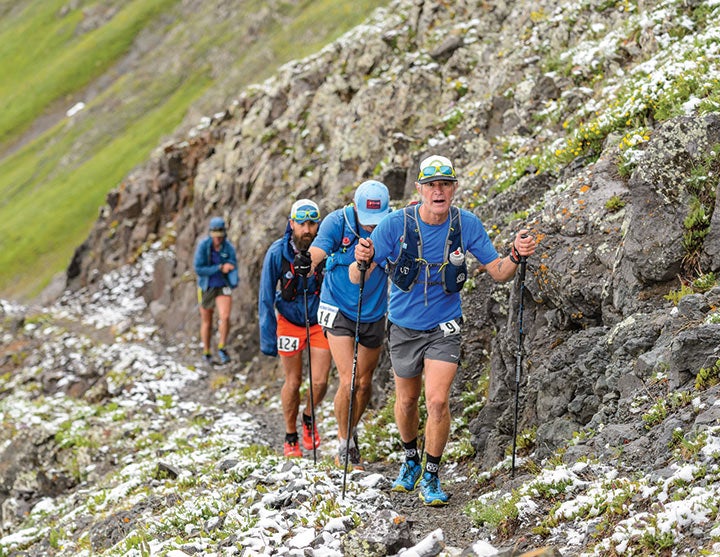
Billy Simpson / 60 / Memphis, TN / 10 Hardrock finishes
The climb up Little Giant Pass, mile 7.0
2015 result: 37:19:57 (44th overall)
At 5:45 a.m., Billy Simpson climbed the steep rock chute to 13,100-foot Virginius Pass, at mile 67.7. He’d felt bad for 67.7 miles. For 40 miles, he hadn’t been able to eat without gagging.
Since first coming to Silverton in 2003—he paced a girlfriend that year, and came back in 2004 to race—Simpson’s driven his truck out, often camping for weeks before the race.
Like many repeat Hardrockers, he was drawn back by the course—seeing so much country “in one fell swoop” impacted him more than a lifetime of backpacking—and the community.
“These people are legends of the mountains,” he says, referring to the hardened likes of Kirk Apt (21 finishes) and Blake Wood (19). “I’m from Memphis. I read about these people in mags. And they just took me in.”
At the Virginius Pass aid station, it’s customary to take a shot of tequila. Simpson, a teetotaler for years, instead “slammed” the non-alcoholic O’Doul’s that aid-station captain Roch Horton always keeps on hand for him. The bitter hops tasted refreshing after “all that sugary junk that you eat” during a race, and the carbonation finally settled Simpson’s stomach.
He felt strong for the final third of the race, finishing in 37:19:57. He had hoped to break 33, a number that’s eluded him, barely, more than once. But “that wasn’t the whole race,” he says.
“I did everything I was supposed to,” he continues. “I had a great time before the race. And it didn’t go my way. That’s sort of like life, and that’s kind of why we run these things. To—I don’t know. Be better people, I guess.”
—
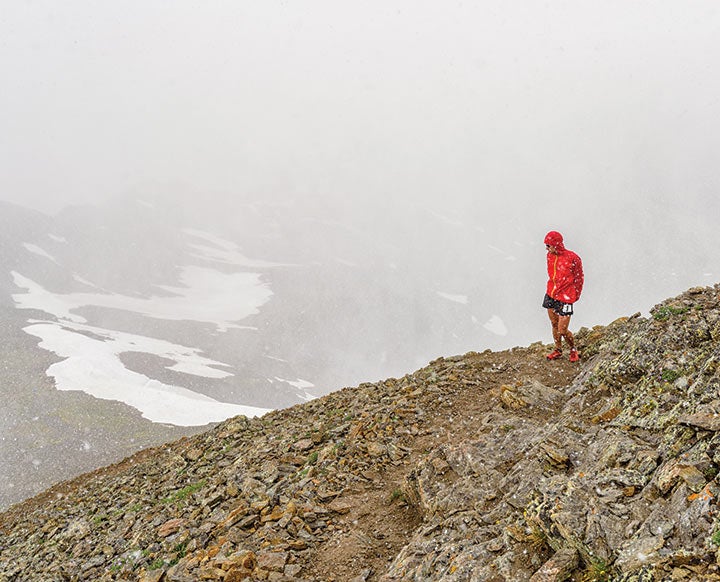
Kilian Jornet / 27 / Spain / 2 Hardrock finishes
Handies Peak, mile 36.8
2015 result: 23:28:10 (1st overall)
In his two Hardrock finishes—2014 and 2015—the world’s most dominant mountain runner has won twice and set two course records, one in each direction.
Perhaps most remarkable, Jornet’s performances looked almost effortless. He showed up this year having trained mostly on skis; his days of “pure running” since the New Year numbered about 15, he told iRunFar. On July 4, six days before Hardrock, Jornet set a course record at Alaska’s Mount Marathon Race, a 5K that climbs and descends a 3,022-foot peak.
Early in this year’s Hardrock, Jornet stayed with the other leaders, but pulled away during the climb up Handies. When he got lost postholing through unmarked snow in Wasatch Basin, 40 miles later, second-place Mike Foote was nearly two hours back.
Six hours after that, wrapped in a blanket, sitting in a folding chair next to the painted rock he’d just kissed, Jornet recalled his favorite part of the course: rocky, vertiginous Virginius Pass, where he and pacer Rickey Gates caught the sunset. “We spent maybe eight to 10 minutes there, just looking,” he told interviewers.
He also indicated that he plans to return. “The mountains are beautiful, but there are many mountains around the world,” he said. “All the aid stations’ people are amazing. It’s really cool, and it’s that that makes the difference.”
This article originally appeared in our October 2015 issue.